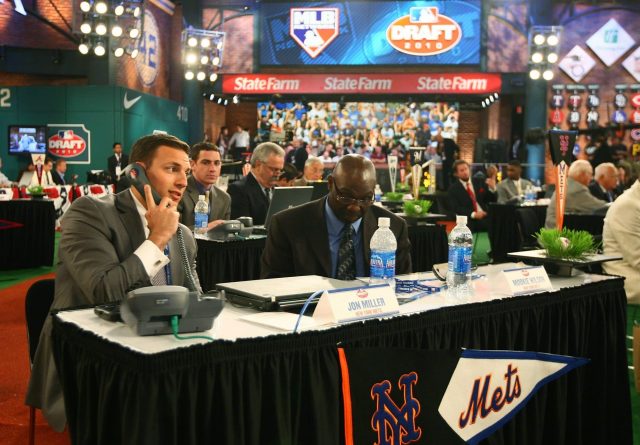Southpaws will headline the New York Mets next pitching generation

The New York Mets farm system has been given flack recently for lacking top prospects, but there’s more there than meets the eye.
When you think of the New York Mets, the first thing that will come to mind is the team’s talented pitching, which makes a lot of sense considering this is an organization that has been built on dominant starting pitching since its inception.
The Mets have employed this philosophy for decades and 2018 will be no different, with three former All-Stars—Jacob deGrom, Matt Harvey, and Noah Syndergaard—set to appear in the rotation. In combination with that major league talent, the current farm system features the pitchers of tomorrow. What makes this next wave of pitching so special? They’re mostly left handed.
Keith Law of ESPN recently released his New York Mets Top Prospects list, which featured southpaws as three of the top seven prospects on the list. Let’s examine what makes Law enamored with these three young guns.
[sc name=”Mets Center”]David Peterson
Peterson highlights the Mets prospect list as Law’s number one prospect in the organization and also takes home the honor of being the only Mets prospect to make his Top 100 Prospect list, where he comes in at No. 58.
In his analysis of Peterson, Law name drops two of the MLB’s best left-handed pitchers as a comparison: “He has a high floor as a back-end starter, but there’s a little Chris Sale/Alex Wood potential here if he adds velocity when he fills out.”
It’s high praise to be compared to two of the game’s most dominant lefties and it also says a lot about Peterson’s future and upside. This is a kid that can throw his fastball with great control and usually sits in the low 90’s in terms of velocity.
Six-foot-six and 240 pounds, Peterson has a big frame that he can still add bulk to, which is why Law speculates that he could add velocity as he matures. In 2017, Peterson appeared in three games with the Brooklyn Cyclones and compiled a 2.45 ERA to begin his professional career.
Despite throwing less than four innings since turning pro, top prospect David Peterson is the #Mets' most major league-ready https://t.co/zzucU7Mbtx
— Baseball America (@BaseballAmerica) January 9, 2018
The 22-year-old’s best pitch is his slider which already sports impressive command, and if he can refine his changeup he will be able to reach that high ceiling.
Thomas Szapucki
Even after sustaining an elbow injury that required Tommy John surgery, Szapucki’s potential and stuff alone have him sitting at No. 7 on Law’s list.
Szapucki made six starts for Low-A Columbia in 2017 and immediately produced top results. In 29 innings he was able to strikeout 27 batters while pitching to an impressive 2.79 ERA.
With a fastball that can reach 97 mph with nasty sinking movement, there’s no doubt as to why the young southpaw has been so successful throughout his minor league career. Szapucki adds a sweeping breaking ball and a work-in-progress changeup as well (sound like Steven Matz to anyone?), which he will need to be effective as he moves into the upper levels of the system.
His potential, which is just like Peterson’s, could provide the Mets with a nice assortment of southpaws to fill the rotation if he continues to progress after a full recovery from surgery.
Anthony Kay
Kay was one of the Mets’ two first-round picks in the 2016 draft. Although he has not yet made his professional debut due to his continued recovery from Tommy John surgery, he still oozes potential.
First-rounders Anthony Kay, David Peterson highlight #Mets instructional league roster https://t.co/vGba6uL18r
— Kyle Glaser (@KyleAGlaser) September 23, 2017
“He was back for instructs in the fall, touching 95 in short outings with a plus changeup and average breaking ball,” wrote Law of his No. 6 prospect in the system. “He could be primed for a big jump with a healthy 2018.”
Law’s praise did not end there as he went on to name Kay the Mets sleeper prospect for the upcoming season.
The young lefty from the University of Connecticut is mostly known as a fastball-changeup pitcher with strong command. In his college career, he worked as both a starter and reliever, which makes him even more valuable due to his versatility and experience in both roles.
Kay also sports a breaking ball in his repertoire that could use some development. If he can effectively deploy these three pitches he could become a mainstay in the rotation.
Even if he continues to be a fastball-changeup reliant pitcher, he could easily transition into a late-inning relief role.
[sc name=”Mets Link Next” link=”https://elitesportsny.com/2018/01/30/eduardo-nunez-does-not-make-sense-for-the-new-york-mets/” text=”Signing Eduardo Nunez Doesn’t Make A Lot Of Sense For Mets” ]I am a Senior currently attending the Rutgers Business School in New Brunswick. I am a lifelong New York Mets fan, and writing about the team is my passion.






